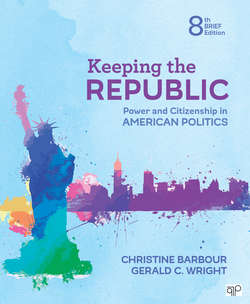Читать книгу Keeping the Republic - Christine Barbour - Страница 37
На сайте Литреса книга снята с продажи.
Who Is a Citizen and Who Is Not?: Native-born and naturalized citizens
ОглавлениеCitizenship is not just a normative concept—that is, a prescription for how governments ought to treat residents and how those residents ought to act. It is also a very precise legal status. A fundamental element of democracy is not only the careful specification of the rights granted and the obligations incurred in citizenship but also an equally careful legal description of just who is a citizen and how that status can be acquired by noncitizens.
If you are born in any of the fifty states, in the District of Columbia, or in most of America’s overseas territories, such as Puerto Rico or Guam, you are an American citizen, whether your parents are Americans or not and whether they are here legally or not. This rule follows the principle of international law called jus soli, which means literally “the right of the soil.” The exceptions to this rule in the United States are children born to foreign diplomats serving in the United States and children born on foreign ships in U.S. waters. These children would not be considered U.S. citizens. According to another legal principle, jus sanguinis (“the right by blood”), if you are born outside the United States to American parents, you are also an American citizen (or you can become one if you are adopted by American parents). Interestingly, if you are born in the United States but one of your parents holds citizenship in another country, you may be able to hold dual citizenship, depending on that country’s laws. Most countries, including the United States, require that a child with dual citizenship declare allegiance to one country on turning age eighteen. It is worth noting that requirements for U.S. citizenship, particularly as they affect people born outside the country, have changed frequently over time.
So far, citizenship seems relatively straightforward. But as we know, the United States since before its birth has been attractive to immigrants, people who are citizens or subjects of another country who come here to live and work. Today there are strict limitations on the numbers of immigrants who may legally enter the country. There are also strict rules governing the criteria for entry. If immigrants come here legally on permanent resident visas—that is, if they follow the rules and regulations of the U.S. Citizenship and Immigration Services (USCIS)—they may be eligible to apply for citizenship through a process called naturalization.
immigrants citizens or subjects of one country who move to another country to live or work
naturalization the legal process of acquiring citizenship for someone who has not acquired it by birth
However, many people who come to the United States do not come as legal permanent residents. The USCIS refers to these people as nonimmigrants. Some arrive seeking asylum, or protection. These are political refugees, who are allowed into the United States if they face or are threatened with persecution because of their race, religion, nationality, membership in a particular social group, or political opinions. Not everyone who feels threatened is given legal refugee status, however. The USCIS requires that the fear of persecution be “well founded,” and it is itself the final judge of a well-founded fear. Claiming refugee status can be an intensely political act, as evidenced by President Trump’s attempt to blame Democrats for the 2018 border crisis caused by his own administration’s policy of separating children from their parents in an effort to deter refugees.14 Refugees may become legal permanent residents after they have lived here continuously for one year (although there are annual limits on the number who may do so), at which time they can begin accumulating the in-residence time required to become a citizen, if they wish to.
refugees individuals who flee an area or a country because of persecution on the basis of race, nationality, religion, group membership, or political opinion
Other people who may come to the United States legally but without official permanent resident status include visitors, foreign government officials, students, international representatives, temporary workers, members of foreign media, and exchange visitors. These people are expected to return to their home countries and not take up permanent residence in the United States.
Profiles in Citizenship Jose Antonio Vargas
Gerry Salva-Cruz
Born in the Philippines, Jose Antonio Vargas was sent by his mother to the United States at age twelve to live with his grandparents, both naturalized U.S. citizens. Until he went to get his driver’s license, Vargas had no idea that the papers that had gotten him into the country were fake, paid for by his family in the hopes of giving him a better life. And his life was great, except for the weight of the secret he carried, forced into a virtual closet and afraid to let anyone except for a few trusted confidants close enough to know him. Even when he became a successful journalist and part of a Pulitzer Prize–winning team at the Washington Post, his anxiety about having his secret revealed was so debilitating that in 2011 he decided to come out of the shadows in a long and moving essay in the New York Times Sunday Magazine. (The Post was afraid to publish the essay because of possible legal repercussions for having hired him.) So far, Vargas is still here, for the most part left to himself by immigration authorities, and he has made himself a voice for the voice-less, founding the nonprofit Define American and working as an immigration-rights activist and a filmmaker. He has become an entrepreneur because, as an undocumented worker, he can employ others but cannot be hired himself.
